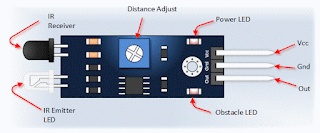Infrared technology
addresses a wide variety of wireless applications. The main areas are sensing
and remote controls. In the electromagnetic spectrum, the infrared portion is
divided into three regions: near-infrared region, mid-infrared region and far-infrared
region.
The wavelengths of these
regions and their applications are shown below.
·
Near-infrared region —
700 nm to 1400 nm — IR sensors, fiber optic
·
Mid-infrared region —
1400 nm to 3000 nm — Heat sensing
·
Far infrared region —
3000 nm to 1 mm — Thermal imaging
The frequency range of
infrared is higher than microwave and lesser than visible light.
For optical sensing and
optical communication, photo optics technologies are used in the near-infrared region as the light is less complex than RF when implemented as a source of the signal. Optical wireless communication is done with IR data transmission for
short-range applications.
An infrared sensor emits
and/or detects infrared radiation to sense its surroundings.
The working of any The infrared sensor is governed by three laws: Planck’s Radiation Law, Stephen –
Boltzmann law and Wien’s Displacement Law.
Planck’s law states that
“every object emits radiation at a temperature not equal to 00K”. Stephen –
Boltzmann law states that “at all wavelengths, the total energy emitted by a
black body is proportional to the fourth power of the absolute temperature”.
According to Wien’s Displacement law, “the radiation curve of a black body for
different temperatures will reach its peak at a wavelength inversely
proportional to the temperature”.
The basic concept of an
Infrared Sensor which is used as an Obstacle detector is to transmit an infrared
signal, this infrared signal bounces from the surface of an object and the a signal is received at the infrared receiver.
There are five basic
elements used in a typical infrared detection system: an infrared source, a
transmission medium, optical component, infrared detectors or receivers, and
signal processing. Infrared lasers and Infrared LEDs of a specific wavelength can be used as infrared sources. The three main types of media used for
infrared transmission are vacuum, atmosphere, and optical fibers. Optical
components are used to focus the infrared radiation or to limit the spectral
response. Optical lenses made of Quartz, Germanium, and Silicon are used to
focus the infrared radiation. Infrared receivers can be photodiodes,
phototransistors, etc. some important specifications of infrared receivers are
photosensitivity, selectivity, and noise equivalent power. Signal processing is
done by amplifiers as the output of the infrared detector is very small
Types of IR Sensors
Infrared sensors can be
passive or active. Passive infrared sensors are basically Infrared detectors.
Passive infrared sensors do not use any infrared source and detect energy
emitted by obstacles in the field of view. They are of two types: quantum and
thermal. Thermal infrared sensors use infrared energy as the source of heat and
are independent of wavelength. Thermocouples, pyroelectric detectors, and
bolometers are the common types of thermal infrared detectors.
Quantum type infrared
detectors offer higher detection performance and are faster than thermal type
infrared detectors. The photosensitivity of quantum type detectors is
wavelength dependent. Quantum type detectors are further classified into two
types: intrinsic and extrinsic types. Intrinsic type quantum detectors are
photoconductive cells and photovoltaic cells.
Active infrared sensors
consist of two elements: an infrared source and an infrared detector. Infrared
sources include an LED or infrared laser diode. Infrared detectors include
photodiodes or phototransistors. The energy emitted by the infrared source is
reflected by an object and falls on the infrared detector.
Types of IR Sensors
Infrared sensors can be
passive or active. Passive infrared sensors are basically Infrared detectors.
Passive infrared sensors do not use any infrared source and detect energy
emitted by obstacles in the field of view. They are of two types: quantum and
thermal. Thermal infrared sensors use infrared energy as the source of heat and
are independent of wavelength. Thermocouples, pyroelectric detectors, and
bolometers are the common types of thermal infrared detectors.
Quantum type infrared
detectors offer higher detection performance and are faster than thermal type
infrared detectors. The photosensitivity of quantum type detectors is
wavelength dependent. Quantum type detectors are further classified into two
types: intrinsic and extrinsic types. Intrinsic type quantum detectors are
photoconductive cells and photovoltaic cells.
Active infrared sensors
consist of two elements: infrared source and infrared detector. Infrared
sources include an LED or infrared laser diode. Infrared detectors include
photodiodes or phototransistors. The energy emitted by the infrared source is
reflected by an object and falls on the infrared detector.
IR Transmitter
Infrared Transmitter is
a light emitting diode (LED) which emits infrared radiations. Hence, they are
called IR LED’s. Even though an IR LED looks like a normal LED, the radiation
emitted by it is invisible to the human eye.
The picture of a typical
Infrared LED is shown below.
There are different
types of infrared transmitters depending on their wavelengths, output power and
response time.
A simple infrared
transmitter can be constructed using an infrared LED, a current limiting
resistor and a power supply. The schematic of a typical IR transmitter is shown
below.


















0 comments:
Post a Comment